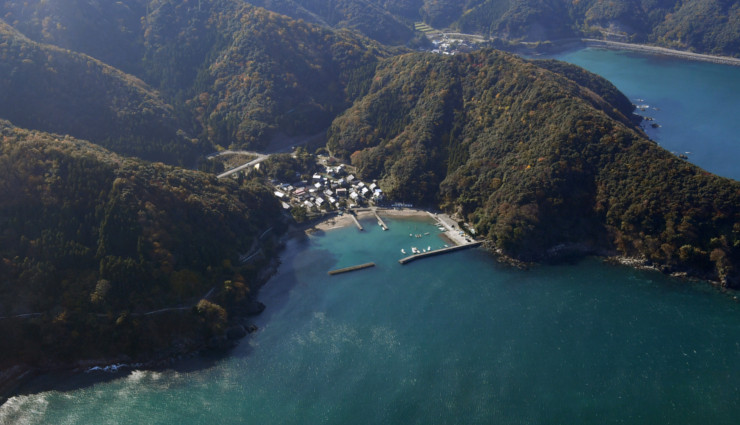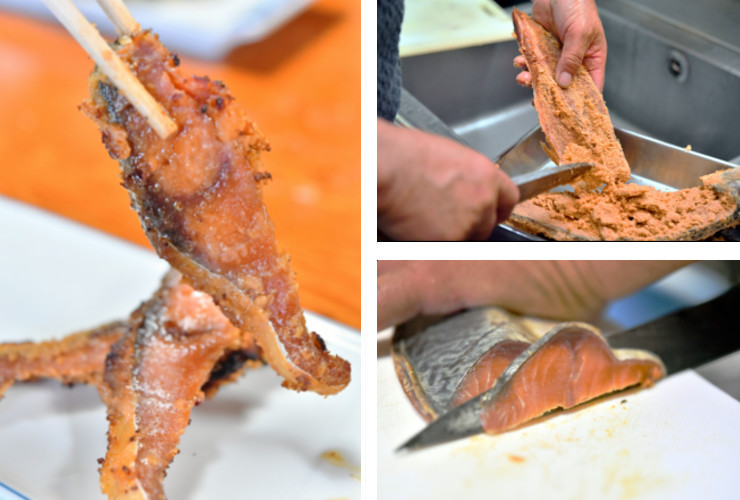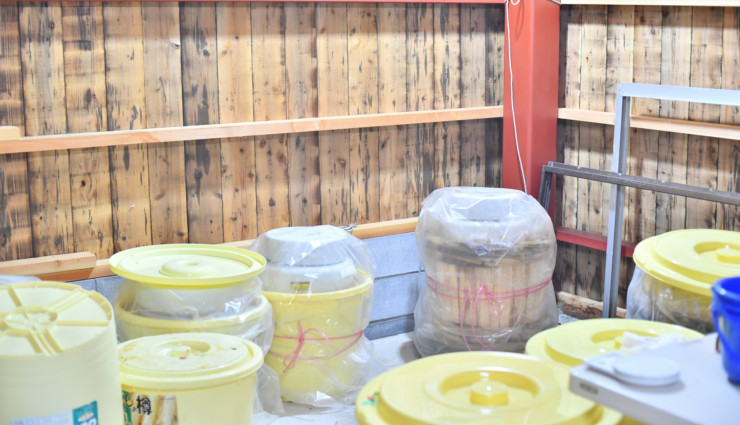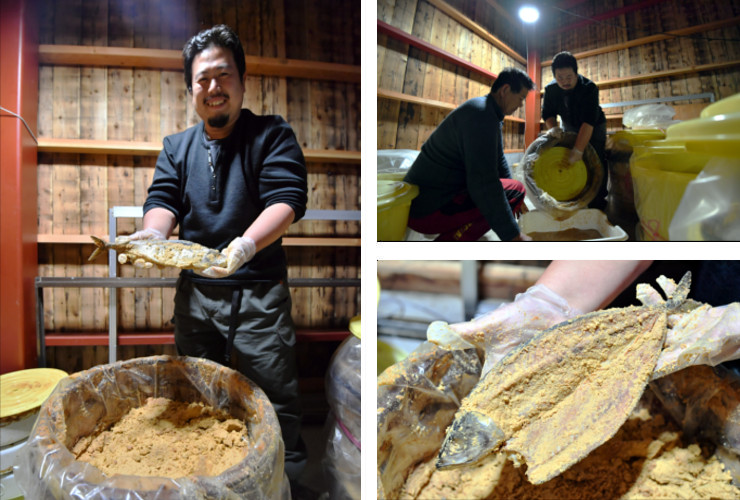January 13th, 2017
by Takeshi Takashima

Fish inevitably spoils or goes rotten soon without stopping the bacteria. Fermentation is one of the common methods to preserve fish for a longer time; e.g., anchovy from the Mediterranean, Stinkheads from Alaska and surströmming known as the smelliest fish from Sweden.
 Fukui Prefecture is one of Japan's premier rice-producing regions and also boasts fishing grounds along the Japanese coast. The exquisite combination of fish and rice gives rise to “Heshiko,” a fermented fish product made using rice bran.
Fukui Prefecture is one of Japan's premier rice-producing regions and also boasts fishing grounds along the Japanese coast. The exquisite combination of fish and rice gives rise to “Heshiko,” a fermented fish product made using rice bran.
 Heshiko is a traditional preserved food from Fukui's fishing villages. Due to the indented bay coastline, each village was isolated. Heshiko represents the wisdom of the local people, devised to ensure food security during harsh winters. It is popular served with rice, paired with sake, enjoyed as sashimi, or lightly grilled.
Heshiko is a traditional preserved food from Fukui's fishing villages. Due to the indented bay coastline, each village was isolated. Heshiko represents the wisdom of the local people, devised to ensure food security during harsh winters. It is popular served with rice, paired with sake, enjoyed as sashimi, or lightly grilled.
 So how is “Heshiko” made? What secrets lie within it?
So how is “Heshiko” made? What secrets lie within it?
 First, the fish (most commonly mackerel) is salt-cured for several weeks before being fermented in rice bran for one year. Mr. Yasuyuki Kosaka, a high school teacher, spent five years researching the traditional “Heshiko” fermentation method at Fukui Prefectural University, elucidating its scientific mechanisms. His findings reveal that the mackerel's proteins are broken down by lactic acid bacteria in the rice bran into peptides and amino acids. This process blends sour, sweet, bitter, and savory flavors, creating a rich and complex taste profile.
First, the fish (most commonly mackerel) is salt-cured for several weeks before being fermented in rice bran for one year. Mr. Yasuyuki Kosaka, a high school teacher, spent five years researching the traditional “Heshiko” fermentation method at Fukui Prefectural University, elucidating its scientific mechanisms. His findings reveal that the mackerel's proteins are broken down by lactic acid bacteria in the rice bran into peptides and amino acids. This process blends sour, sweet, bitter, and savory flavors, creating a rich and complex taste profile.
 Several products made with “Heshiko” are sold as Fukui Prefecture specialties. For example, Mr. Kadono Takashi (32), a fisherman in the small village of Yashiro in Obama City, produces only 500 handcrafted Heshiko annually based on Mr. Kosaka's scientific recommendations. His unique methods—using “salt equivalent to 20% of the mackerel's weight” and “only rice bran from pesticide-free rice”—make Mr. Kadono's handcrafted Heshiko highly sought after, selling out every year.
Several products made with “Heshiko” are sold as Fukui Prefecture specialties. For example, Mr. Kadono Takashi (32), a fisherman in the small village of Yashiro in Obama City, produces only 500 handcrafted Heshiko annually based on Mr. Kosaka's scientific recommendations. His unique methods—using “salt equivalent to 20% of the mackerel's weight” and “only rice bran from pesticide-free rice”—make Mr. Kadono's handcrafted Heshiko highly sought after, selling out every year.
 Besides bluefish, squid, horse mackerel, and pufferfish can also be used to make “Heshiko.” The “Millet Bran Group,” initiated by the wives of fishermen in Koshina, Fukui City, has also developed bottled canned squid “Heshiko” marinated in olive oil.
Besides bluefish, squid, horse mackerel, and pufferfish can also be used to make “Heshiko.” The “Millet Bran Group,” initiated by the wives of fishermen in Koshina, Fukui City, has also developed bottled canned squid “Heshiko” marinated in olive oil.
 From chefs to foodies around the world, “Heshiko” is steadily gaining popularity. Its potential remains largely untapped, poised to be widely adopted not only in traditional Japanese cuisine but also in modern Western dishes like salad dressings and pasta sauces.
From chefs to foodies around the world, “Heshiko” is steadily gaining popularity. Its potential remains largely untapped, poised to be widely adopted not only in traditional Japanese cuisine but also in modern Western dishes like salad dressings and pasta sauces.
What kind of dish would you make with Heshiko? Let's share our ideas together.
【抄訳】
魚は、バクテリアの発生を抑制しなければ、すぐに腐ってしまいます。発酵は、魚を長期間保存するための手法のひとつであり、たとえば、世界には、地中海のアンチョビや、アラスカのスティンクヘッド、“最も臭い魚”と言われるスウェーデンのシュールストレミングなどがあります。
福井は、日本の米どころのひとつであり、日本海岸の漁場を有する地域。魚と米の絶妙な組み合わせを活用し、『へしこ』と呼ばれる、米ぬかで発酵させた魚が生まれました。
へしこは、福井の漁村の、伝統的な保存食です。リアス式海岸となっているため、村々は孤立していました。へしこは、とりわけ厳しい冬に食料を確保するための、地元の人々の知恵の賜物です。米や日本酒とともに、さしみで食べたり、軽くあぶって食べるのが、好まれています。
では、へしこは、どのようにつくられていくのでしょう。そこに、何か秘密はあるのでしょうか。
まず、魚(多くはサバ)を数週間、塩漬けし、さらに、米ぬかに1年、漬けて、発酵させます。高校教師である小坂康之さんは、福井県立大学で5年間、伝統的なへしこの製法を研究し、科学的なメカニズムを解明しました。その研究結果によると、米ぬかに含まれる乳酸菌によって、サバのタンパク質が、ペプチドとアミノ酸に分解され、酸味、甘み、苦み、うまみが混ざり合った、豊かな味わいになるそうです。
へしこをもととする商品は、福井の特産品として、いくつか市販されています。たとえば、小浜市の小さな集落・矢代で漁師を営む角野高志(かどの・たかし)さん(32)は、小坂さんからの科学的なアドバイスをもとに、年間500匹限定で、へしこを手づくりしています。「塩の量はサバの重さの2割とする」、「無農薬米のぬかだけを使用する」といった独自の製法により、角野さんの手づくりのへしこは、とても人気で、毎年、完売しています。
へしこは、イカ、シイラ、フグなど、サバ以外の魚介類でも、つくることができます。福井市越迺の漁師の妻らによる『ぬかちゃんグループ』では、いかのへしこをオリーブオイルで漬けた瓶詰めを開発しました。
へしこは、国内外のシェフや食通から、徐々に人気を集めはじめています。潜在的な可能性をまだまだ秘めており、伝統的な和食のみならず、サラダのドレッシングやパスタソースなど、洋風の現代料理にも、幅広く使えそうです。
あなたなら、へしこで、どんな料理をつくりますか。みんなでアイデアを共有してみましょう。